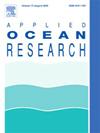双重强化增产提高海洋水合物储层渗透率和稳定性的可行性评价:浆液-沉积物胶结特征
IF 4.3
2区 工程技术
Q1 ENGINEERING, OCEAN
引用次数: 0
摘要
南海天然气水合物储层胶结性弱、强度低、渗透率低,严重制约了其经济效益。为了克服这些挑战,我们提出了一种创新的双强化增产方法,即通过劈裂注浆注入浆液。这种浆液经过原位固化,形成多孔、高强度和高渗透性的通道。该方法的成功取决于对泥浆与储层沉积物之间胶结模式的理解,以及胶结界面处的渗透率动态。本研究探讨了泥沙胶结界面的微观特征,评价了泥沙复合材料附近和内部渗透率的变化。观察到,在凝固过程中,浆液侵入沉积物,导致界面厚度大于55µm。这种侵入改变了界面处沉积物的孔隙结构,使其孔隙度降低40%以上,从而降低了渗气性,破坏了泥沙耦合样品的渗透率。固结后,偶联试样的渗透性损伤达到75%左右,但随着浆料中渗透性增强剂的排放,其渗透性损伤降至27%。此外,压降系数的评估表明,与瓜尔胶压裂液和纯水改造的水合物储层相比,聚氨酯浆液改造的水合物储层具有更好的渗透率。这表明,双强化增产泥浆对储层渗透率的损害最小,证明了其在提高储层渗透率和强度方面的可行性。本研究提出了一种安全高效提取海洋水合物的新型增产方法。本文章由计算机程序翻译,如有差异,请以英文原文为准。

Feasibility assessment of enhancing permeability and stability in marine hydrate reservoirs with dual-enhanced stimulation: Slurry-sediment cementation characteristics
Natural gas hydrate reservoirs in the South China Sea exhibit weak cementation, low strength, and low permeability, which severely restricts their commercial viability. To overcome these challenges, we propose an innovative dual-enhanced stimulation method involving slurry injection via splitting grouting. This slurry undergoes in-situ solidification, forming porous, high-strength, and high-permeability channels. The method's success hinges on understanding cementation patterns between the slurry and reservoir sediments, along with the permeability dynamics at the cementation interface. This study explored the microscopic features of the slurry-sediment cementation interface and evaluated changes in permeability nearby and within the slurry-sediment composite. It was observed that during the solidification process, the slurry invaded the sediments, resulting in an interface thickness more than 55µm. This invasion altered the pore structure of the sediment at the interface, reducing its porosity by more than 40 %, which in turn decreased gas permeability and damaged the permeability of the slurry-sediment coupled sample. After consolidation, the permeability damage of the coupled sample reached about 75 %, but it decreased to 27 % with the discharge of the permeability-enhancer in the slurry. Additionally, the evaluation of the pressure drop coefficient revealed that hydrate reservoirs stimulated with polyurethane slurry exhibit superior permeability compared to those transformed with guar gum fracturing fluid and pure water. This suggests that the dual-enhanced stimulation slurry causes minimal damage to reservoir permeability, demonstrating its feasibility in enhancing both permeability and strength of the reservoir. This study presents a novel stimulation method for the safe and efficient extraction of marine hydrates.
求助全文
通过发布文献求助,成功后即可免费获取论文全文。
去求助
来源期刊

Applied Ocean Research
地学-工程:大洋
CiteScore
8.70
自引率
7.00%
发文量
316
审稿时长
59 days
期刊介绍:
The aim of Applied Ocean Research is to encourage the submission of papers that advance the state of knowledge in a range of topics relevant to ocean engineering.
 求助内容:
求助内容: 应助结果提醒方式:
应助结果提醒方式:


